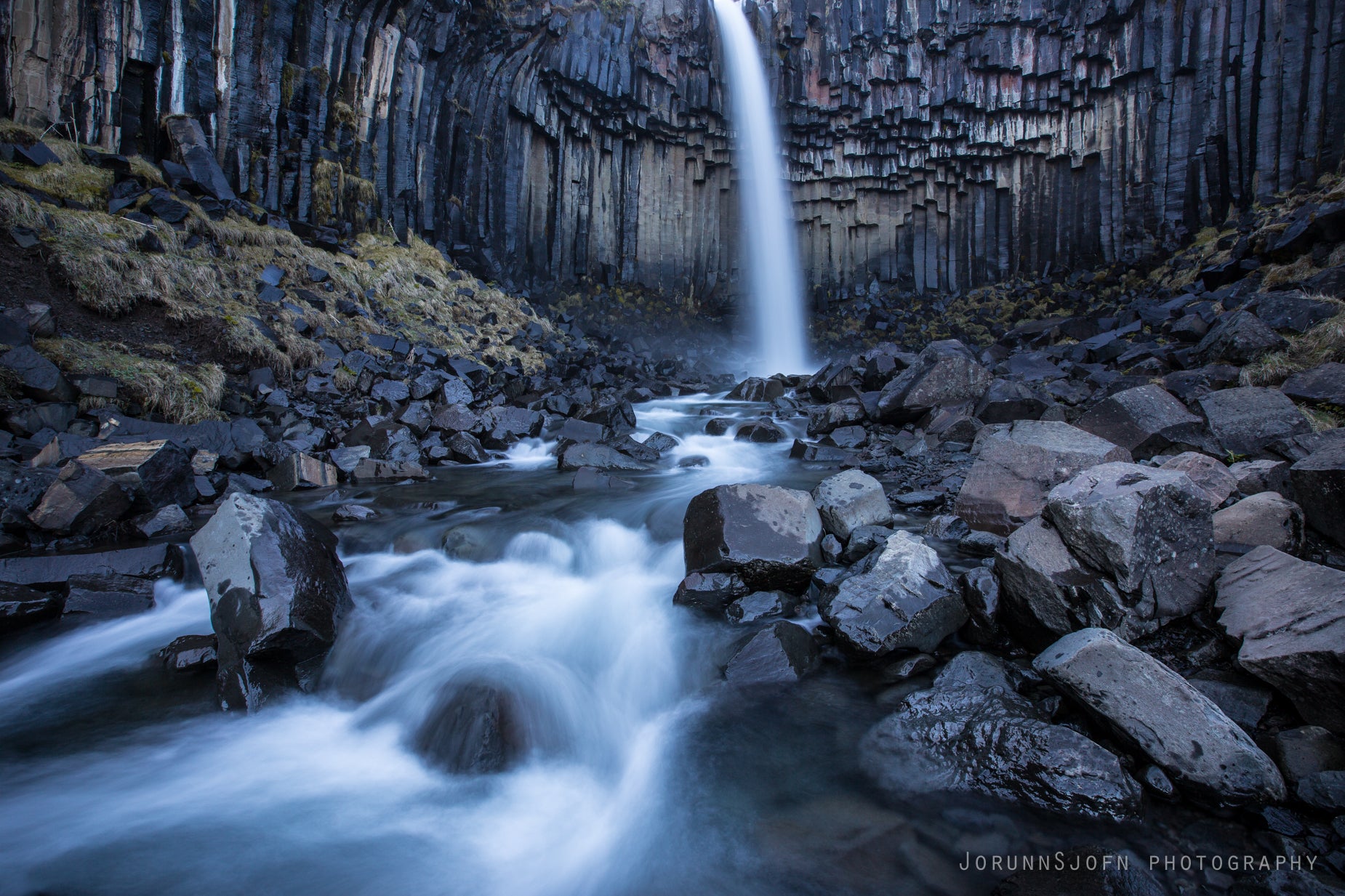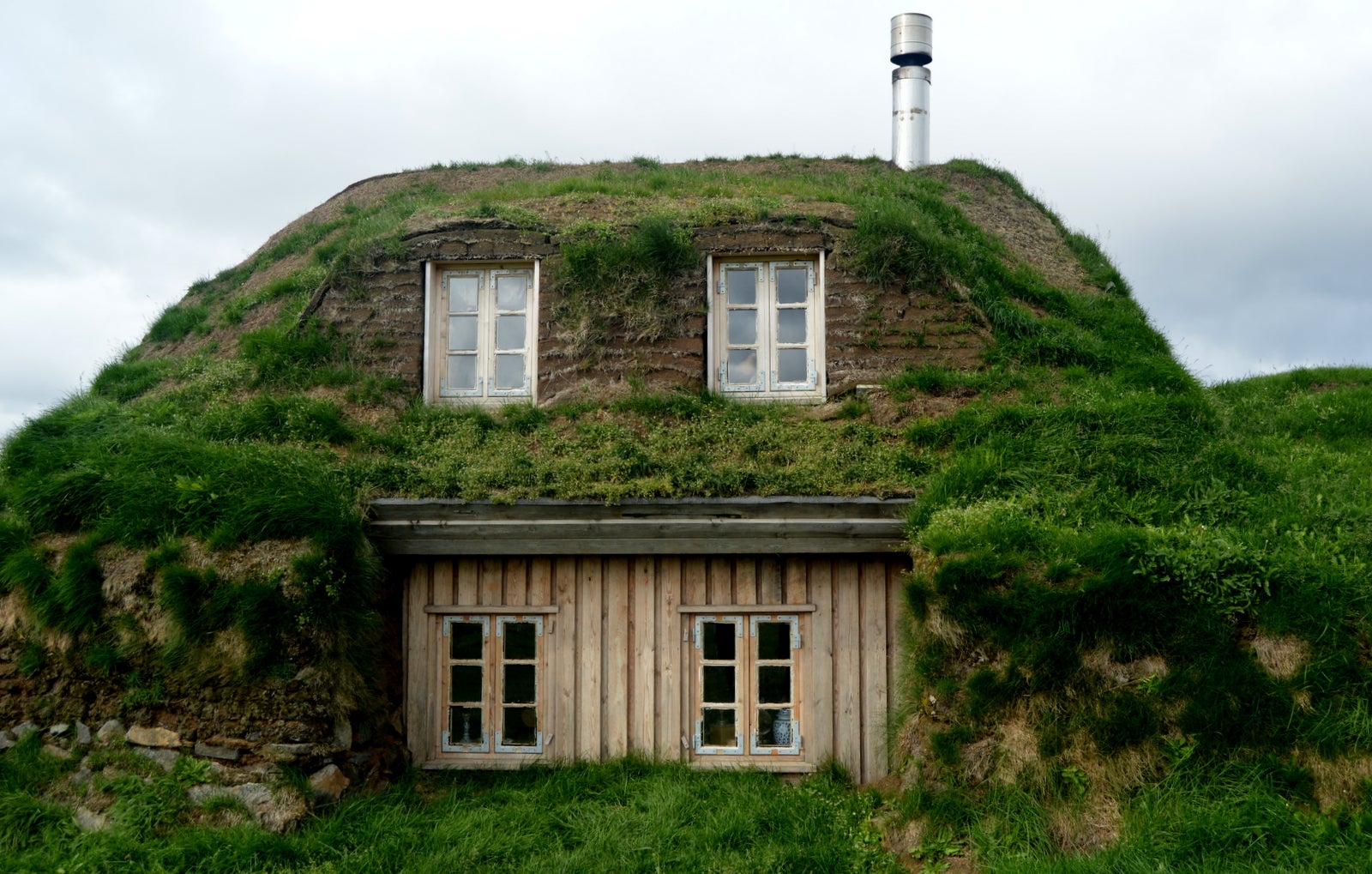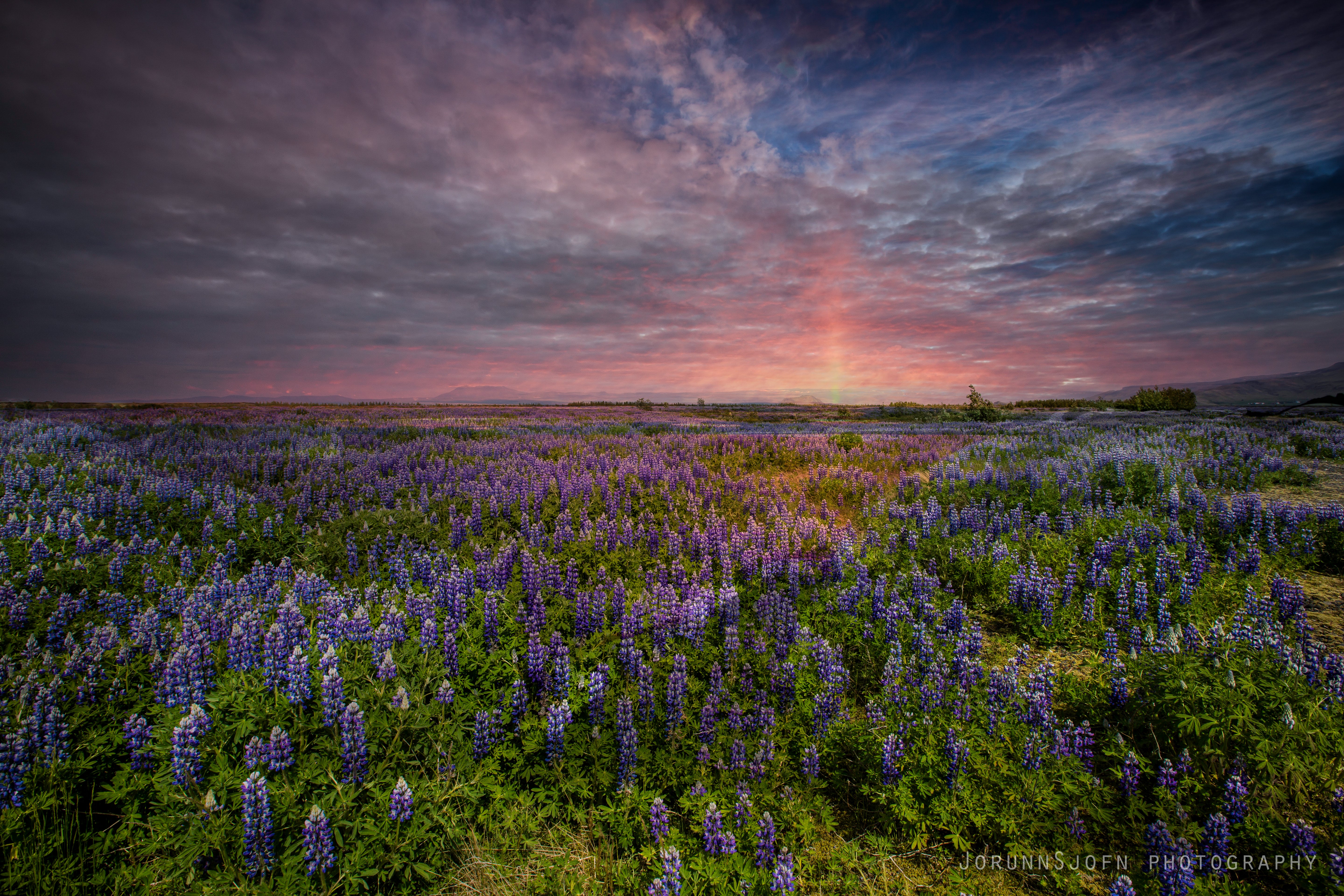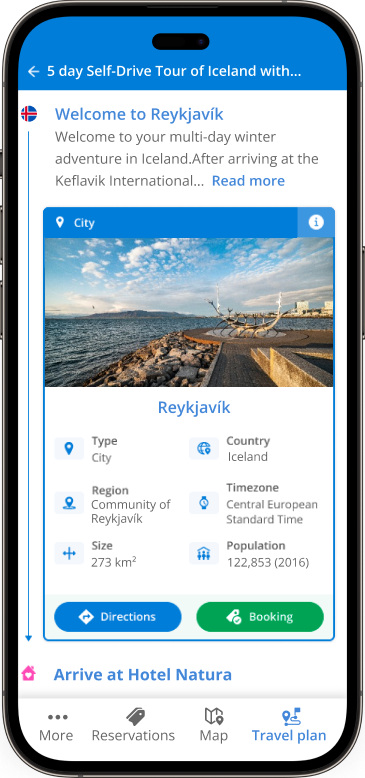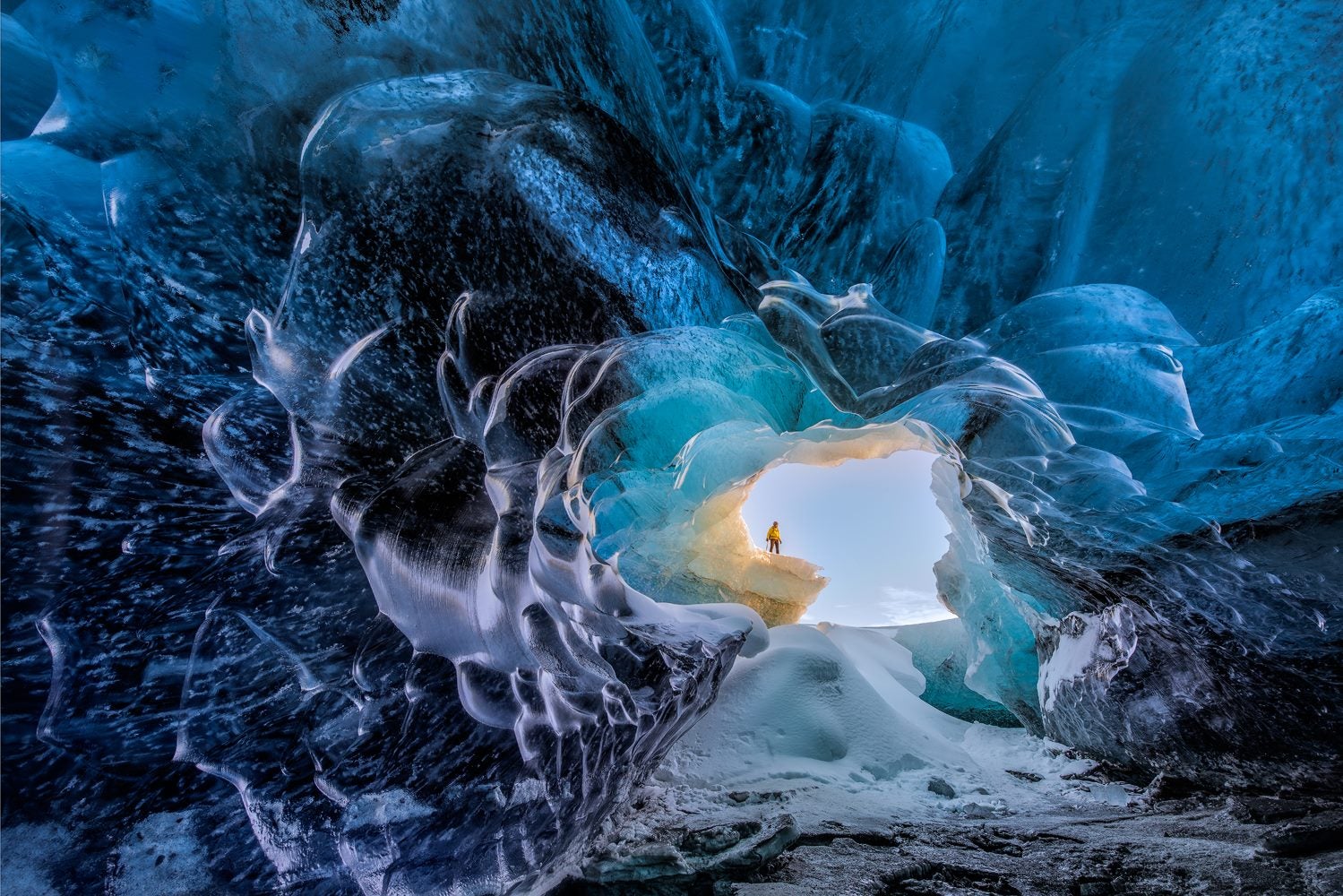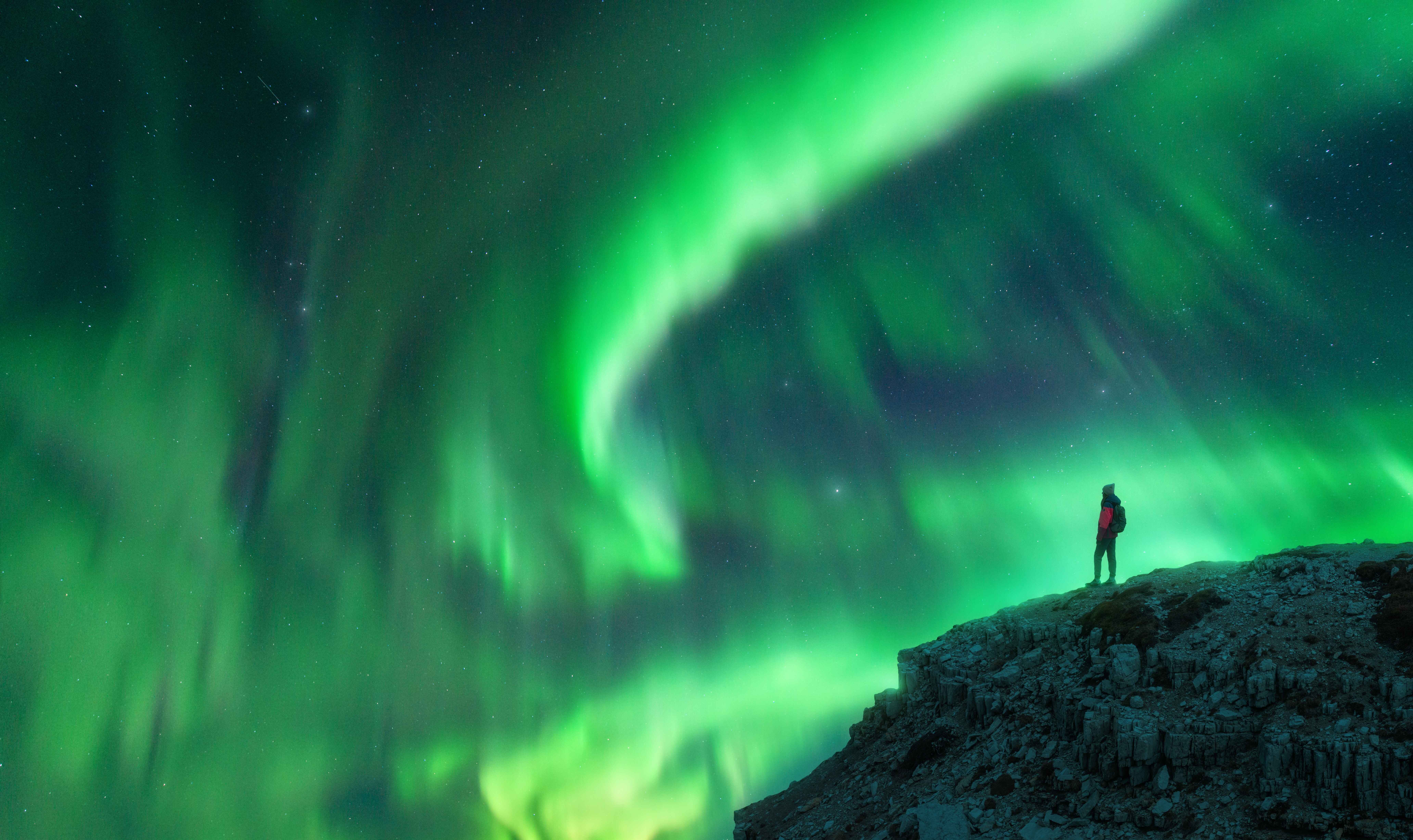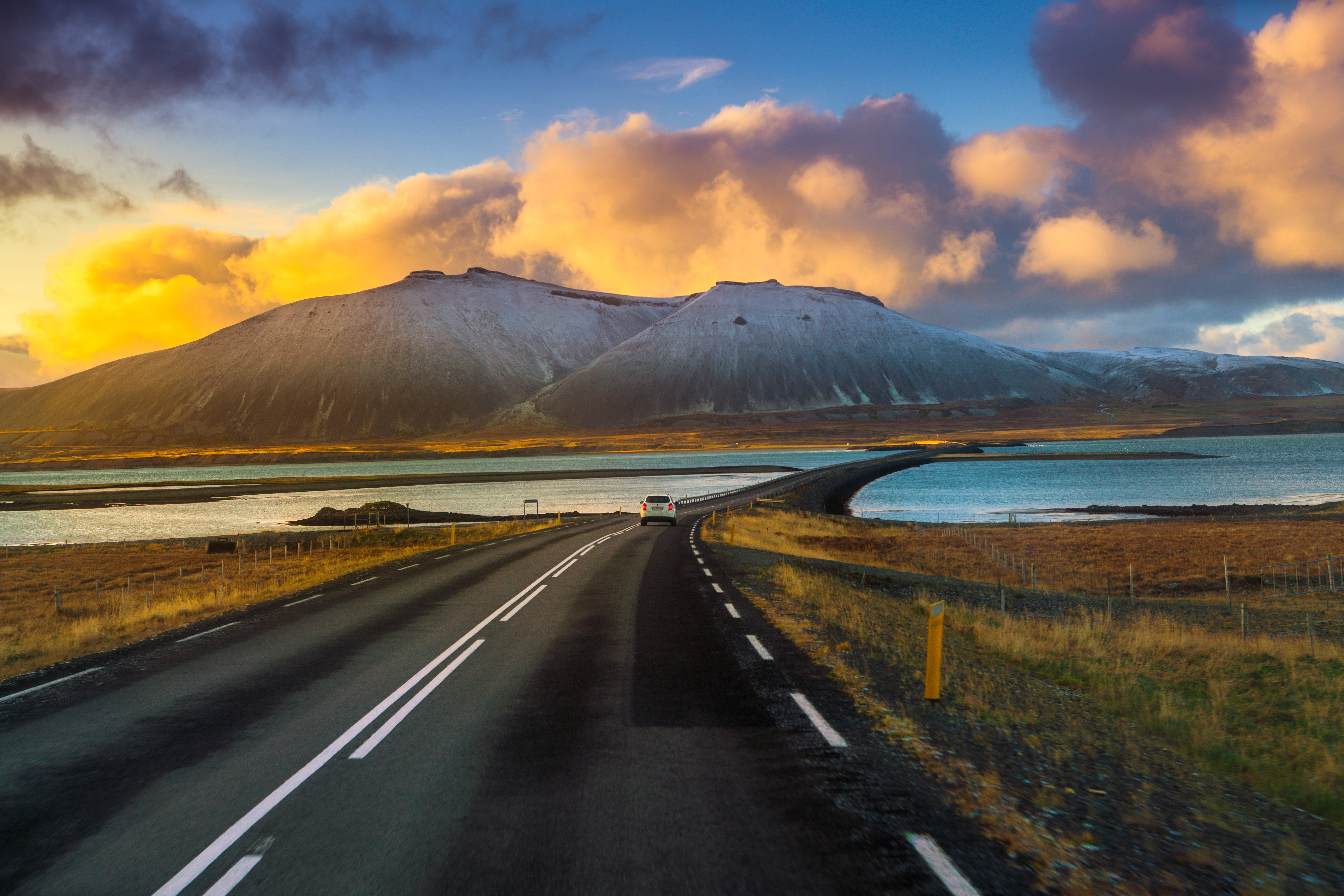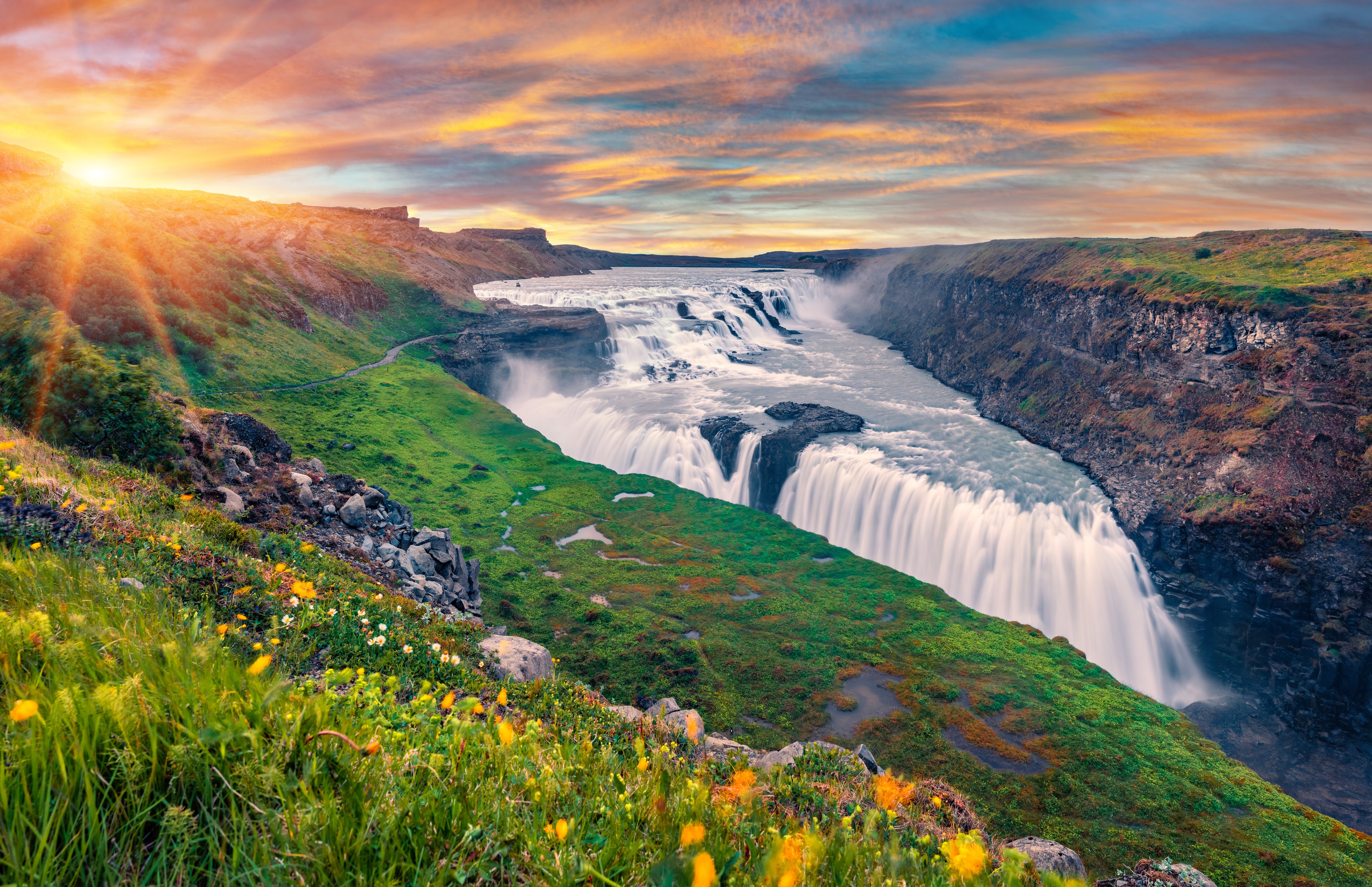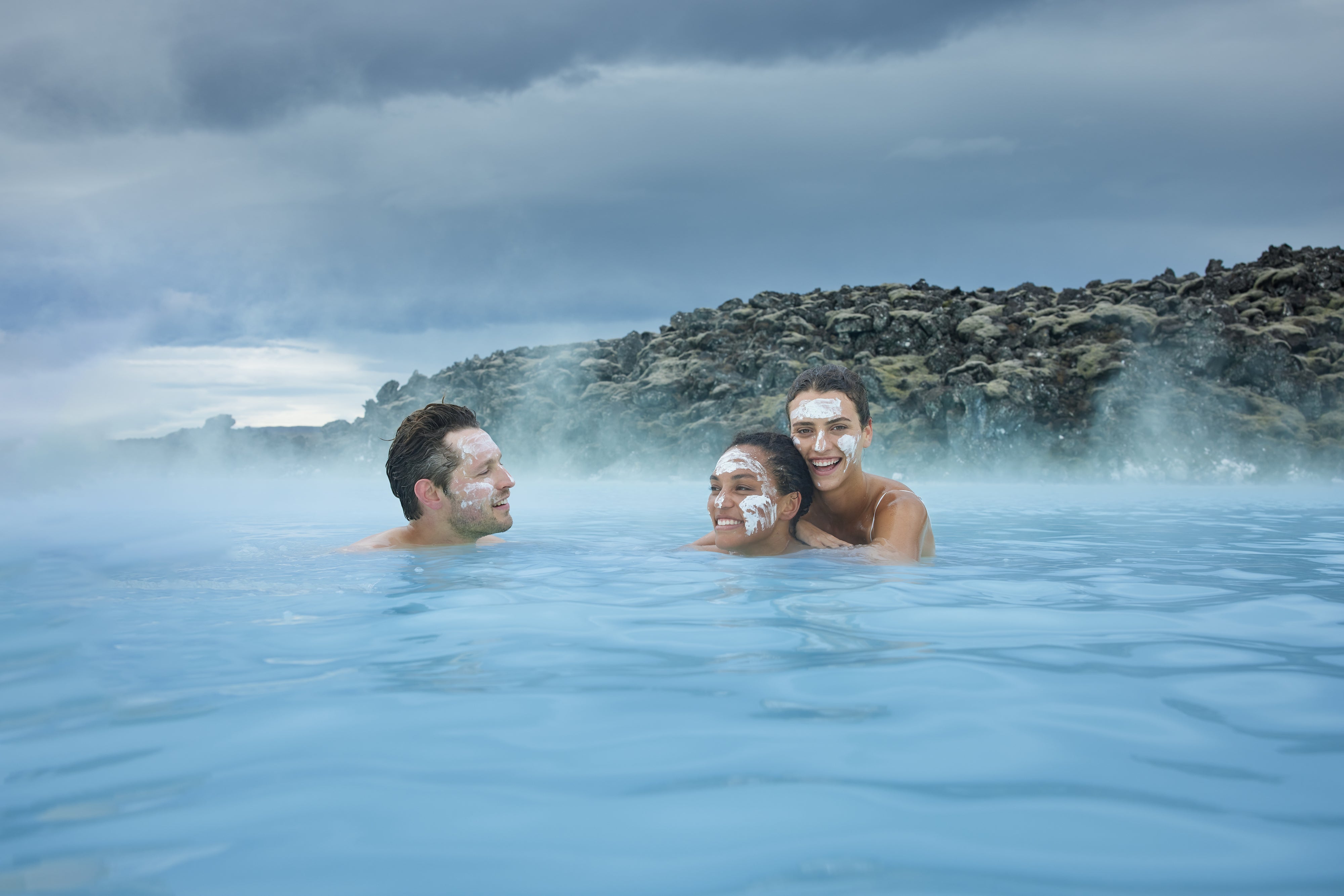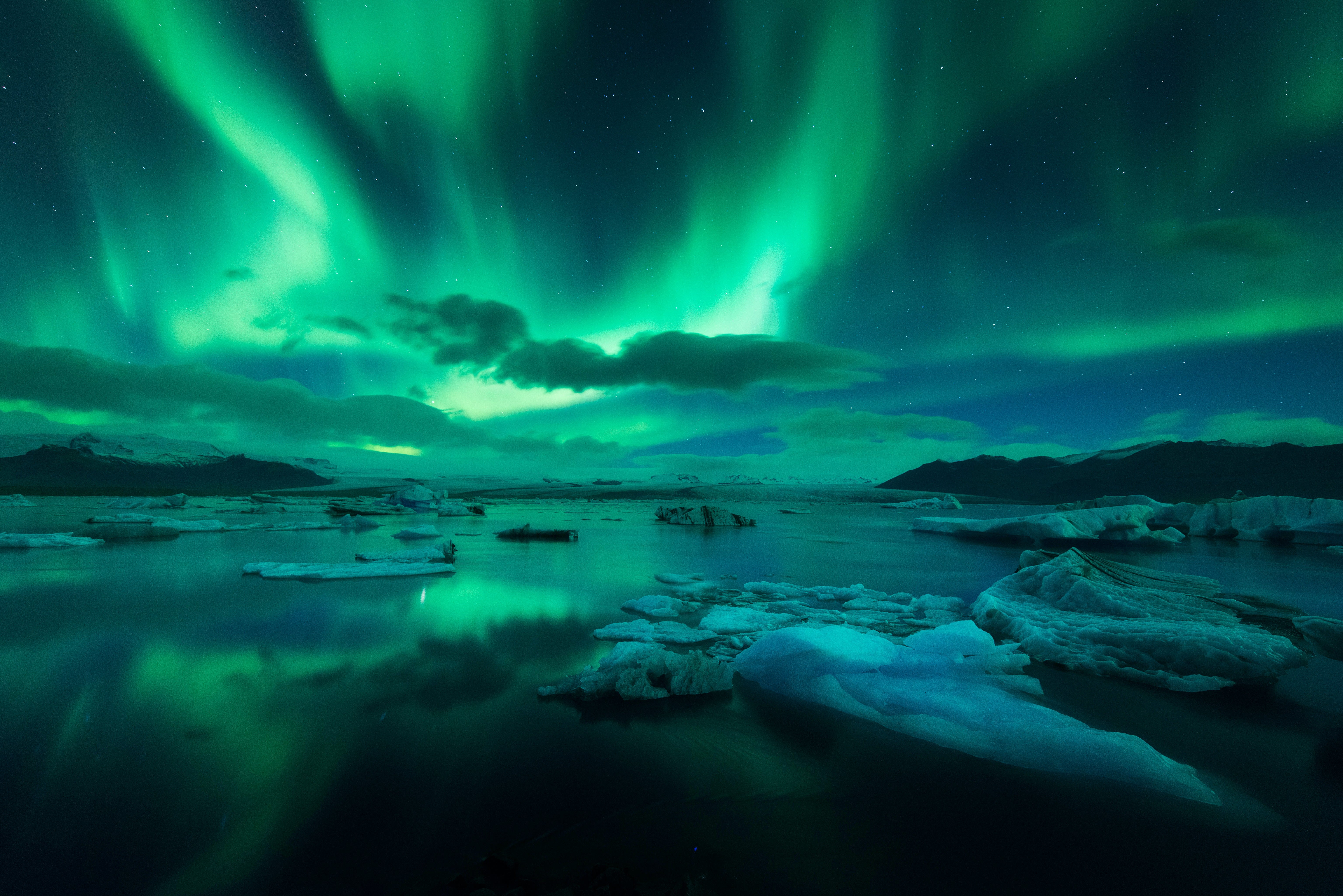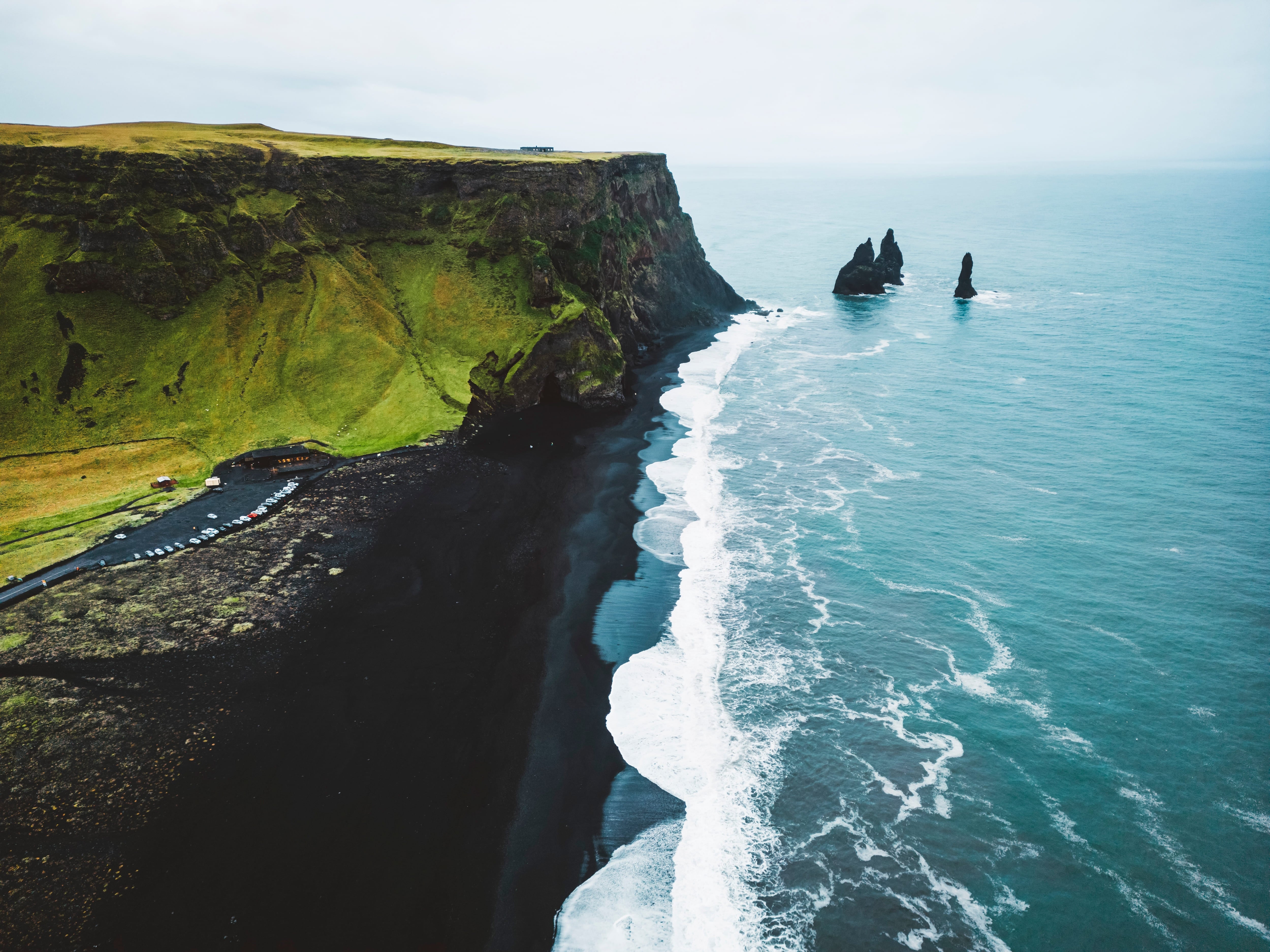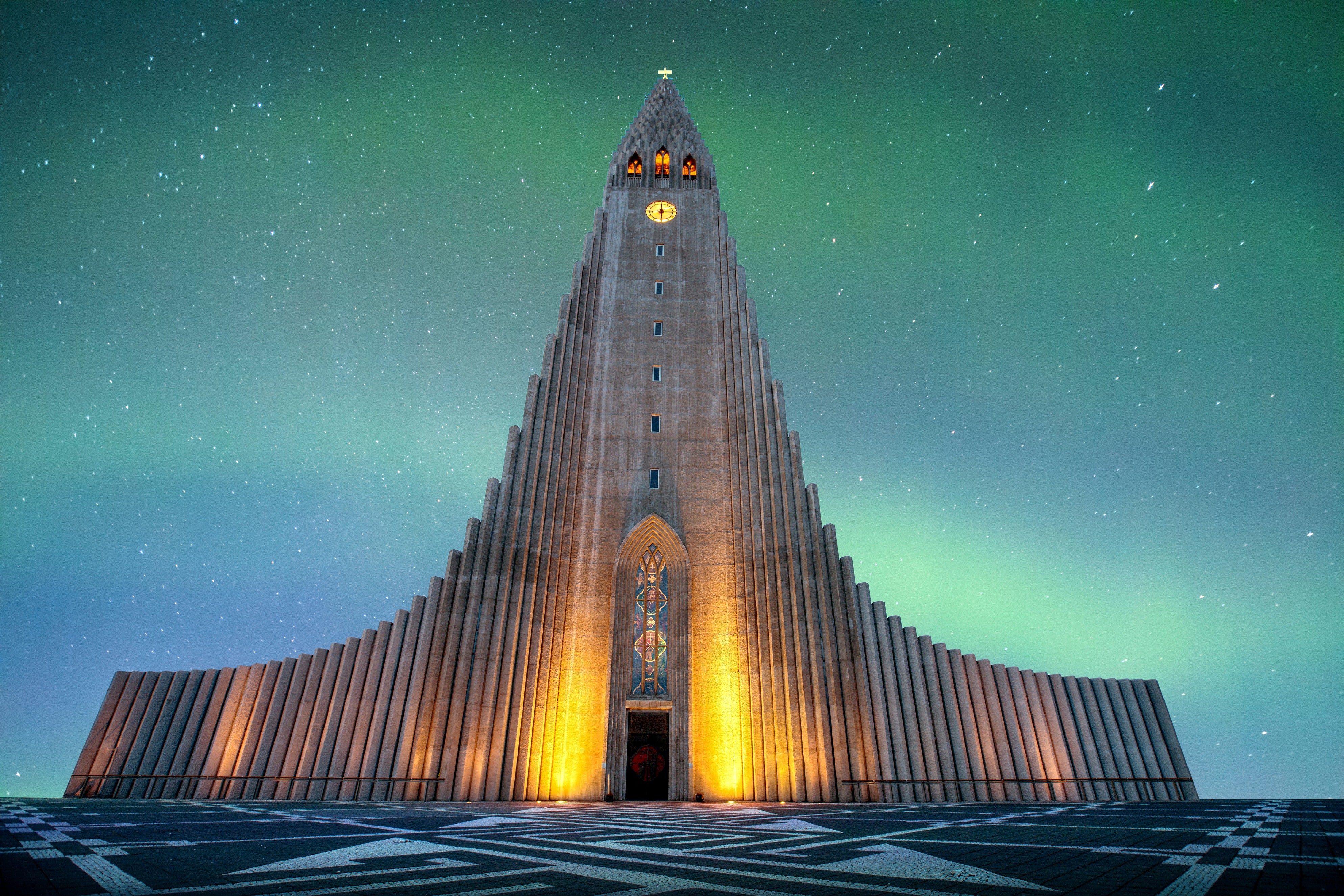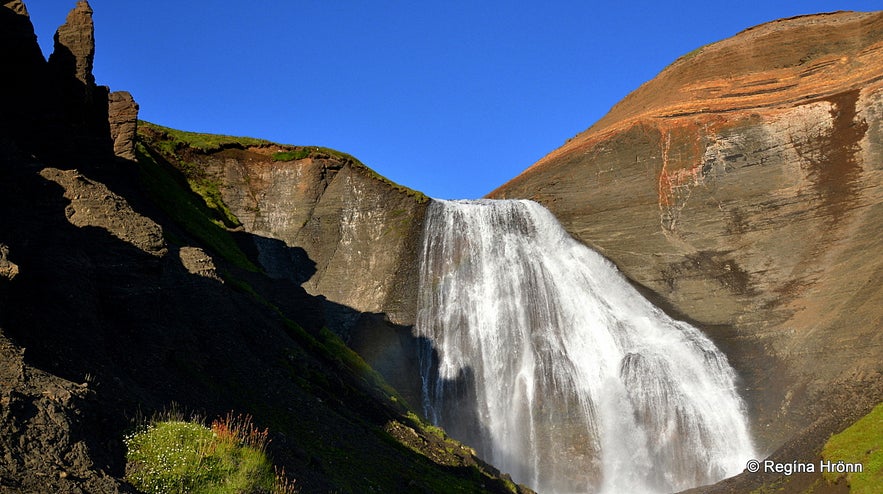
This beautiful coastal waterfall is called Skeifárfoss - the Waterfall in the Skeifá river. This area is also well-known for the unique Tjörneslögin sedimentary strata, and during WWI, there were 2 lignite mines in this area.
Top photo: Skeifárfoss waterfall
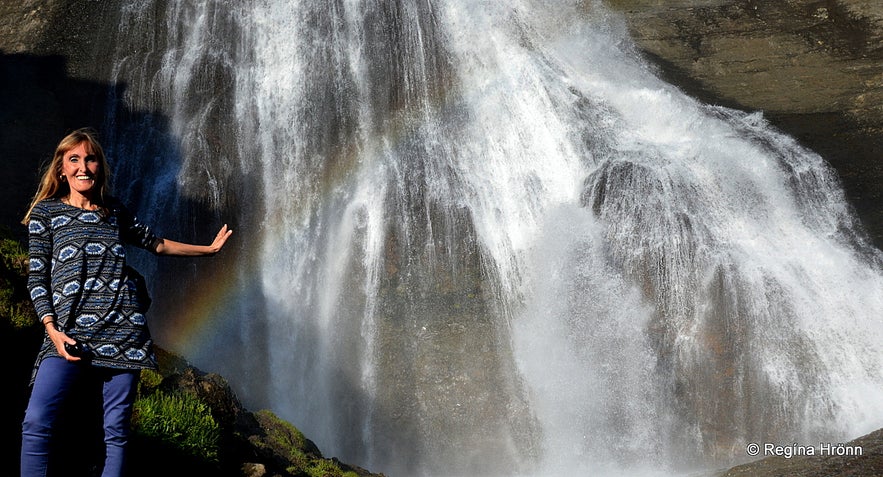
Touching the rainbow by Skeifárfoss
Skeifárfoss waterfall cascades down from a sedimentary cliff like a bridal veil, and the river Skeifá runs its way for a short distance into the sea.
In Iceland, we have three Jewel Circles, which take us around Iceland's pearls of nature. In South Iceland, we have the popular Golden Circle, the Silver Circle in the west, and the Diamond Circle in North Iceland.
A Local's Guide to the Golden Circle Tour in Iceland
The spectacular Silver Circle in West Iceland
The spectacular Diamond Circle in North Iceland
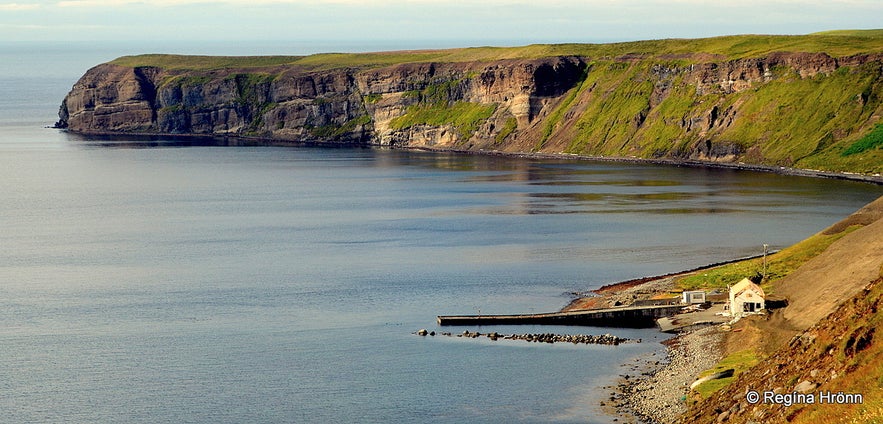 Tungulending
Tungulending
Tjörnes connects 2 destinations on the Diamond Circle, Húsavík town, which is referred to as the Whale Watching capital of Iceland, and where my grandmother was born, and Ásbyrgi, which is my favourite pearl of Iceland.
The Tjörnes peninsula is located on the Tjörnes fracture zone, and earthquakes are frequent in this part of Iceland.
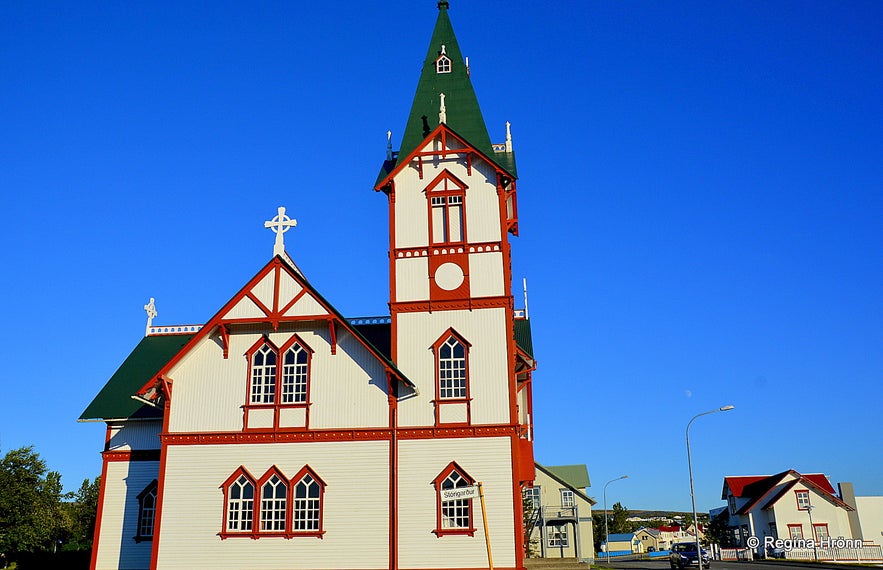 Húsavíkurkirkja church, the landmark of Húsavík - and the 2 houses my ancestors built in 1907
Húsavíkurkirkja church, the landmark of Húsavík - and the 2 houses my ancestors built in 1907
We drove 12 north from Húsavík town to reach Tungulending, where the Tjörneslögin sedimentary strata can be seen, and from where the hike to the waterfall starts.
We visited this area a few years ago, and back then, we opened a gate on the road (always close gates behind you) and drove down the steep hill and parked our car by the Tungulending guesthouse.
The guesthouse by the harbour was used by local fishermen at Tjörneshöfn.
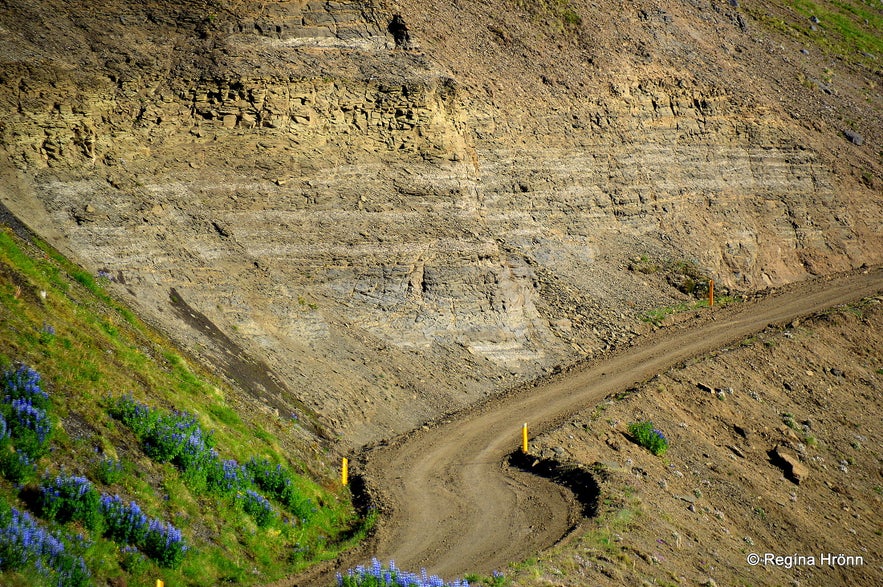 The steep gravel road leading down to the sea cuts through Tjörneslögin fossils
The steep gravel road leading down to the sea cuts through Tjörneslögin fossils
A steep gravel road takes you down to Tungulending, from where we started the hike on the beach.
While descending this steep road, you will see the ancient Tjörneslögin fossils in the rocks. I will tell you about them a little later in my travel-blog.
We left the car by Tungulending, and off we went to visit Skeifárfoss waterfall.
I had no idea how far the hike was, but we aimed at seeing the waterfall in the evening sun, when the sun was shining directly at it.
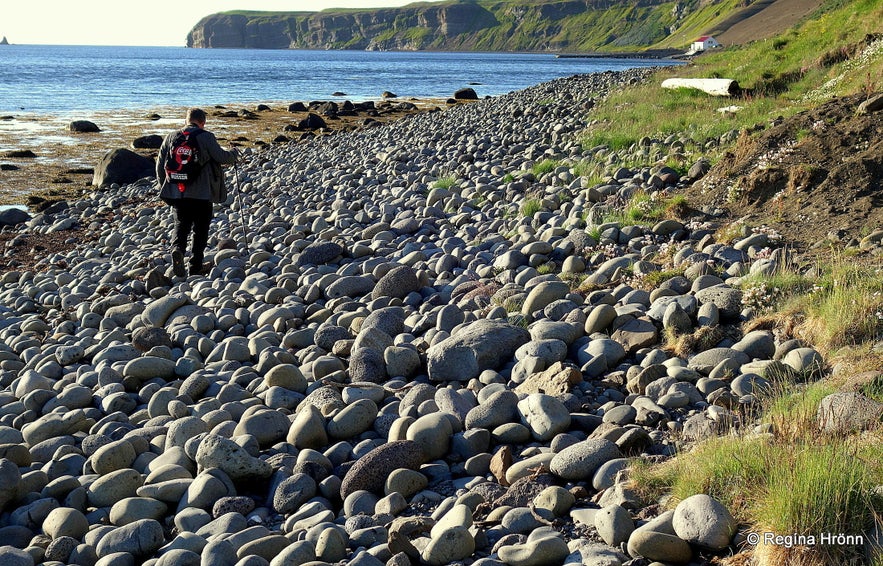 We hiked on the rocky beach
We hiked on the rocky beach
The beach is very rocky, and as I have always found it hard to walk on such rocky beaches and look very out of place, stumbling about, I looked for another option.
So I opted for walking the kindastígur - the path of the sheep on the grass, where it was possible. The sheep paths are quite narrow, so you have to have good balance to follow them.
I brought my hiking stick, and would recommend that you bring a hiking stick if you are anything like me.
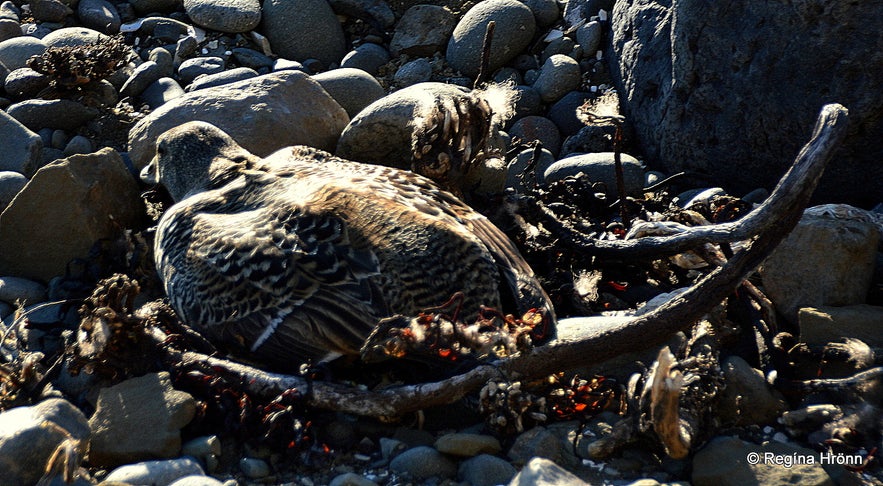 The eider duck on its nest blended in and was almost invisible
The eider duck on its nest blended in and was almost invisible
Birdlife is varied here, and we almost stepped on an eider duck in camouflage and were quite startled, more so than the eider duck nesting on the beach.
It didn't budge, but then eider ducks are known for not flying from their nests when disturbed.
I guess that its heart was beating as fast as ours. It blended in so well and was totally quiet, so it was invisible to us, and we would for sure not have wanted to harm it.
I took a video of Skeifárfoss
After an hour's hike on the rocky beach, always hoping that the waterfall would be behind the next bend, we reached Skeifárfoss waterfall.
I was in awe when it finally appeared, all lit up by the sun, and it even sported a rainbow. The waterfall, which is around 30 meters tall, looked like a painting, just picture perfect.
We had reached it at the exact right time, when the evening summer sun shone directly at Skeifárfoss.
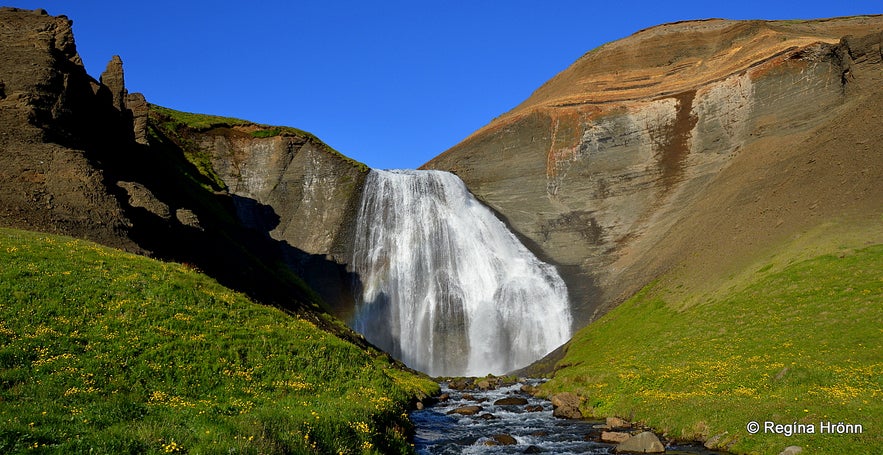
The waterfall beautifully cascades down from the sedimentary layers
We were in the nick of time though, when the sun still lit up the waterfall (at 20:00) and made the bright colours of the light brown Tjörneslög sedimentary layers against the blue sky more vivid.
We were very lucky, as we live 470 km away from Tjörnes, and the weather could have been cloudy or rainy.
Skeifá river runs its course into the sea just a little below the waterfall.
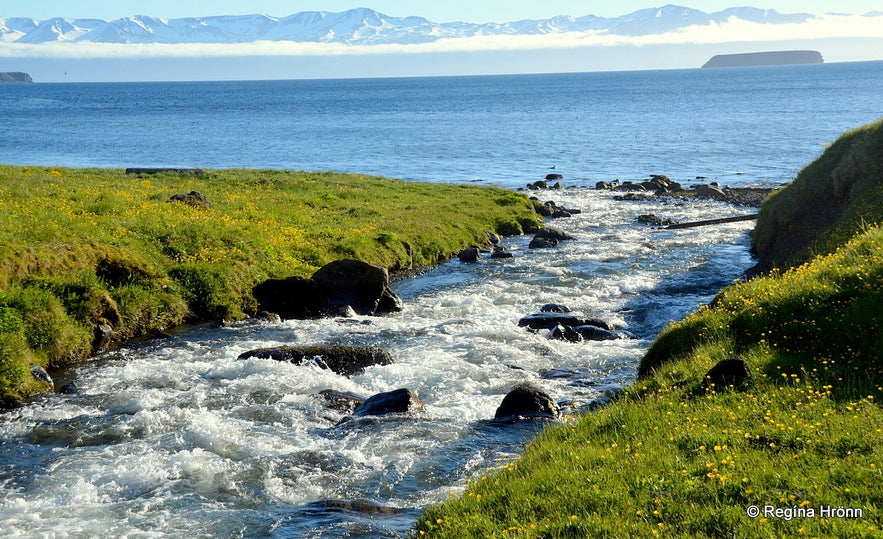 Skeifá river runs its course into Skjálfandaflói bay - Lundey island can be seen in the distance
Skeifá river runs its course into Skjálfandaflói bay - Lundey island can be seen in the distance
There are a couple of islands by the Tjörnes peninsula. Two of them are called Mánáreyjar islands, Háey and Lágey, which translates into the High and Low Island.
The third island, Lundey - the Puffin Island, is the biggest of these islands, and it can be seen clearly from the beach by Skeifárfoss.
The mountains in the distance are called Kinnarfjöll.
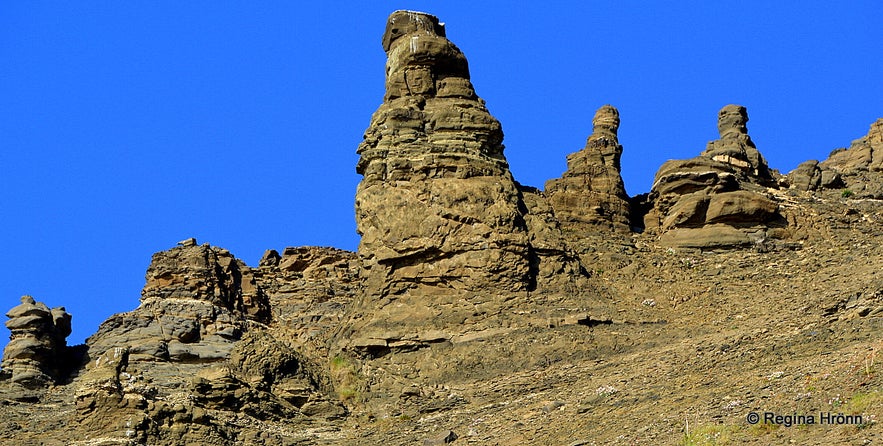 Pillars of rock on the Tjörnes peninsula
Pillars of rock on the Tjörnes peninsula
We admired Skeifárfoss and took in the beauty of this area, and then headed back along the rocky beach, as the waterfall began to get darkened by a shadow.
Do you notice the trolls in the cliffs - the pillars of rocks? They might be the protectors of the waterfall, as I believe that waterfalls always have a protector, be it a rock or a water spirit, as I told you about in my travel-blog about Gjáin in Þjórsárdalur valley.
The return hike took us more than an hour, as we stopped in several places and took photos, and explored the lignite and the fossils on the beach.
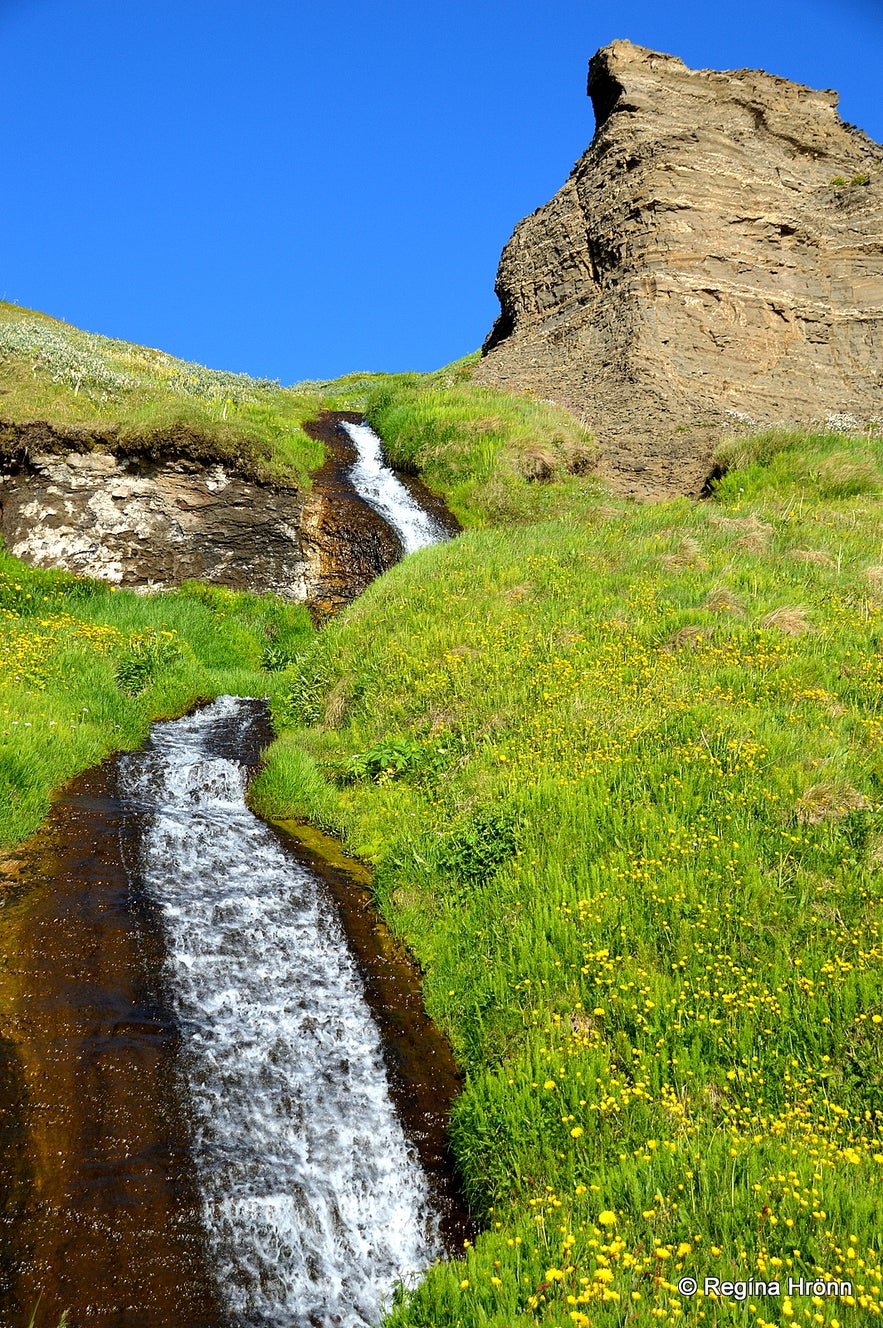 We saw this pretty little waterfall on our hike on the beach
We saw this pretty little waterfall on our hike on the beach
You will see the Tjörnes fossils embedded in the sea cliff walls and crumbling from them.
While walking along the beach, you will also see fossils in abundance, ancient fossilised conches, and seashells.
It pained me to see the fossils being washed away by the waves and disappearing into the sea.
I saw a large piece about to be washed out to sea, and I took it up to examine it before it was washed away by the waves of the Atlantic Ocean.
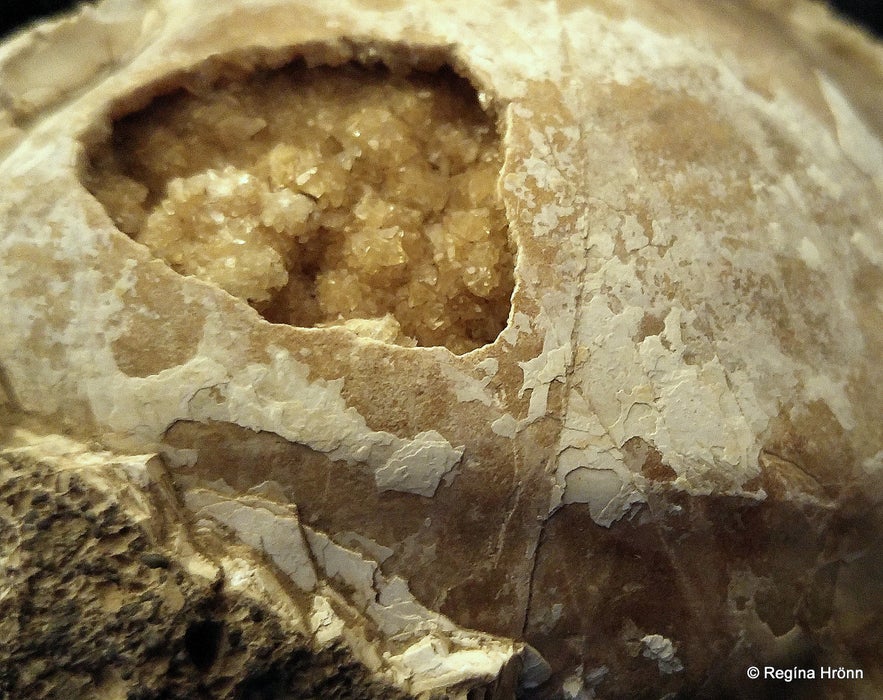 I took a photo of a fossil while it was about to be taken away by the waves
I took a photo of a fossil while it was about to be taken away by the waves
It was a large shell, and inside it I saw glistening crystals.
I put it down again and wished it well as the waves washed it away. I wanted to keep it, but it is forbidden to remove the fossils.
Surtabrandur - lignite on the beach
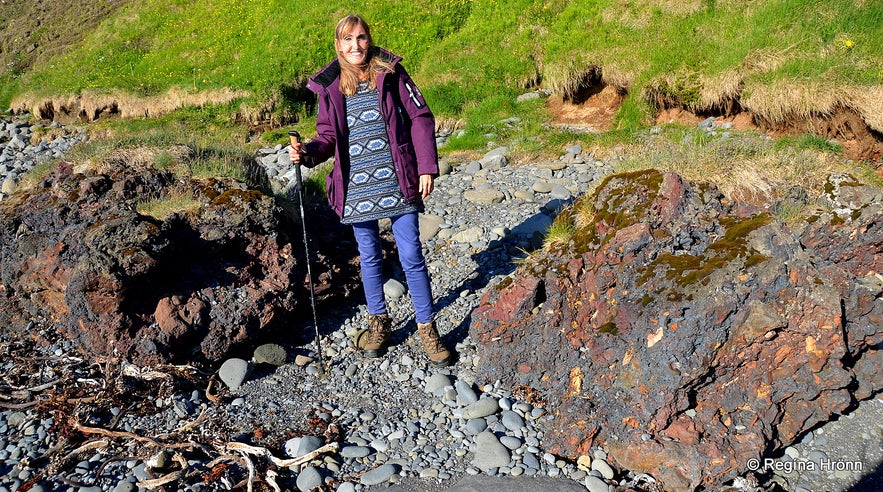 Lignite on the beach
Lignite on the beach
On the beach, you will also see big rocks that look like red lava. They are leftover lignite that couldn't be used when the lignite mines were in use during WWI.
I read in an account that from 1918-1920, there were embers of fire in these huge leftover piles from the lignite mines.
This lignite came from 2 mines, as lignite, which we call surtarbrandslög layers (surtarbrandur = lignite), was mined here in 1916-1918 (and for some time after that). The mines have now collapsed.
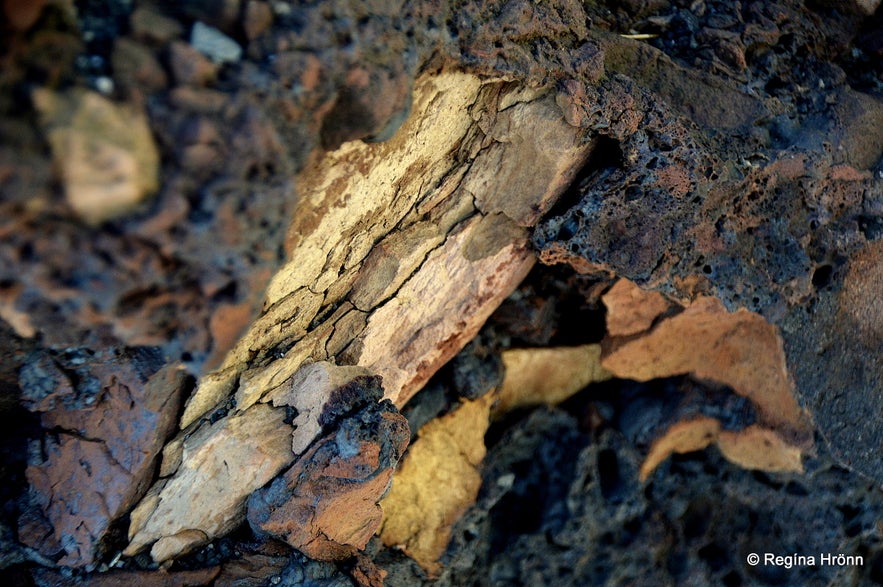 Lignite – brown coal up close
Lignite – brown coal up close
During WWI (1914-1918), enough coals couldn't be imported to Iceland. So the locals tried mining lignite during these difficult times.
The lignite didn't work as well as coals, as lignite is not a particularly effective fuel, but they for sure helped. Icelandic houses weren't heated with hot water back then, like they are today.
Mining lignite worked best here on Tjörnes and at Skarð in Skarðsströnd, as I have shown you in another travel-blog: Fellsströnd and Skarðsströnd in West Iceland, the Saga Circle of Iceland.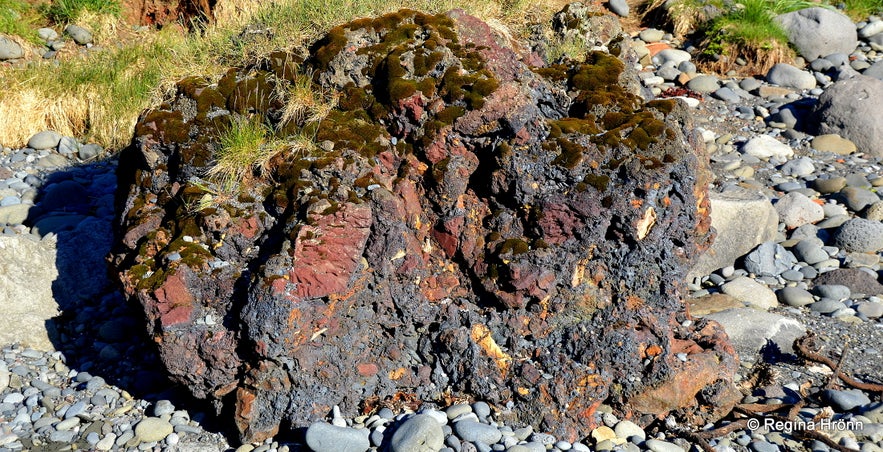 Lignite on the beach
Lignite on the beach
There were 2 lignite mines in use, one of which was owned by the Hringver farm, Hringversnáma, and was operated by Þorsteinn Jónsson, fishing operator.
The other one was in the possession of Ytri-Tunga farm, Ytri-Tungunáma, and was run by the state.
My husband's great-uncle, Jón J. Víðis, wrote in an article about the mines in the newspaper back in 1917, that around 70 people worked in the state-run mine at some point, and in addition to the miners, there were also cooks and carpenters.
They mainly stayed in tents, but the kitchen was in a temporary shed. A shed for the workers was then (in 1917) being built by Tungulending.
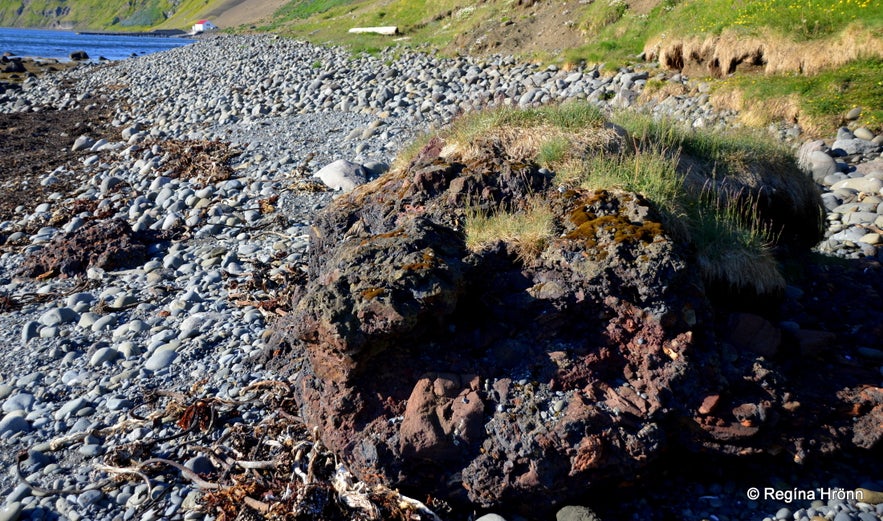 Lignite on the beach, Tungulending in the distance
Lignite on the beach, Tungulending in the distance
My great-grandfather, Bjarni Benediktsson (1877-1964), was back then general merchant at Húsavík. He moved to Húsavík from the Grenjaðarstaður turf farm, and in 1907, he built 2 houses with his father in Húsavík.
In 1914, Bjarni built a shed on the shore by Hallbjarnarstaðir farm, from which lignite was sold. It was a small branch from the store and post office in Bjarnabúð in Húsavík, and he got help from the farmer of Hallbjarnarstaðir, Kári Sigurjónsson, who sold the lignite for him.
It was not easy living on an island this far up north when the world was on fire. We still rely heavily on imported goods here in Iceland, and hope that imports will never stop again to our island.
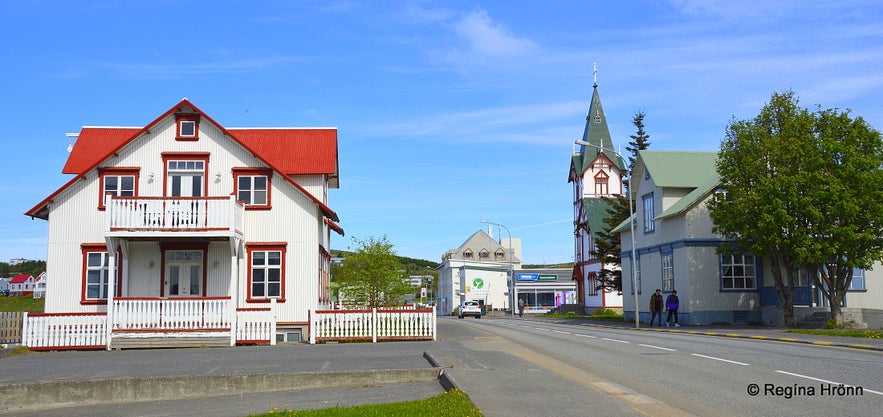 My great-grandfather built the two houses opposite each other, Bjarnabúð and Bjarnahús
My great-grandfather built the two houses opposite each other, Bjarnabúð and Bjarnahús
Times were hard, and the weather was not cooperating. 1918 was terribly cold and goes down in history as Frostaveturinn mikli - the Year of the Great Frost. And the Spanish flu swept the nation.
On top of that, the notorious volcano Katla erupted in South Iceland, but we all fear its eruptions, as they are cataclysmic.
I read in the biography of Bjarni Benediktsson, gathered by his son, Stefán, that from January until March, drift ice from Greenland closed the harbours.
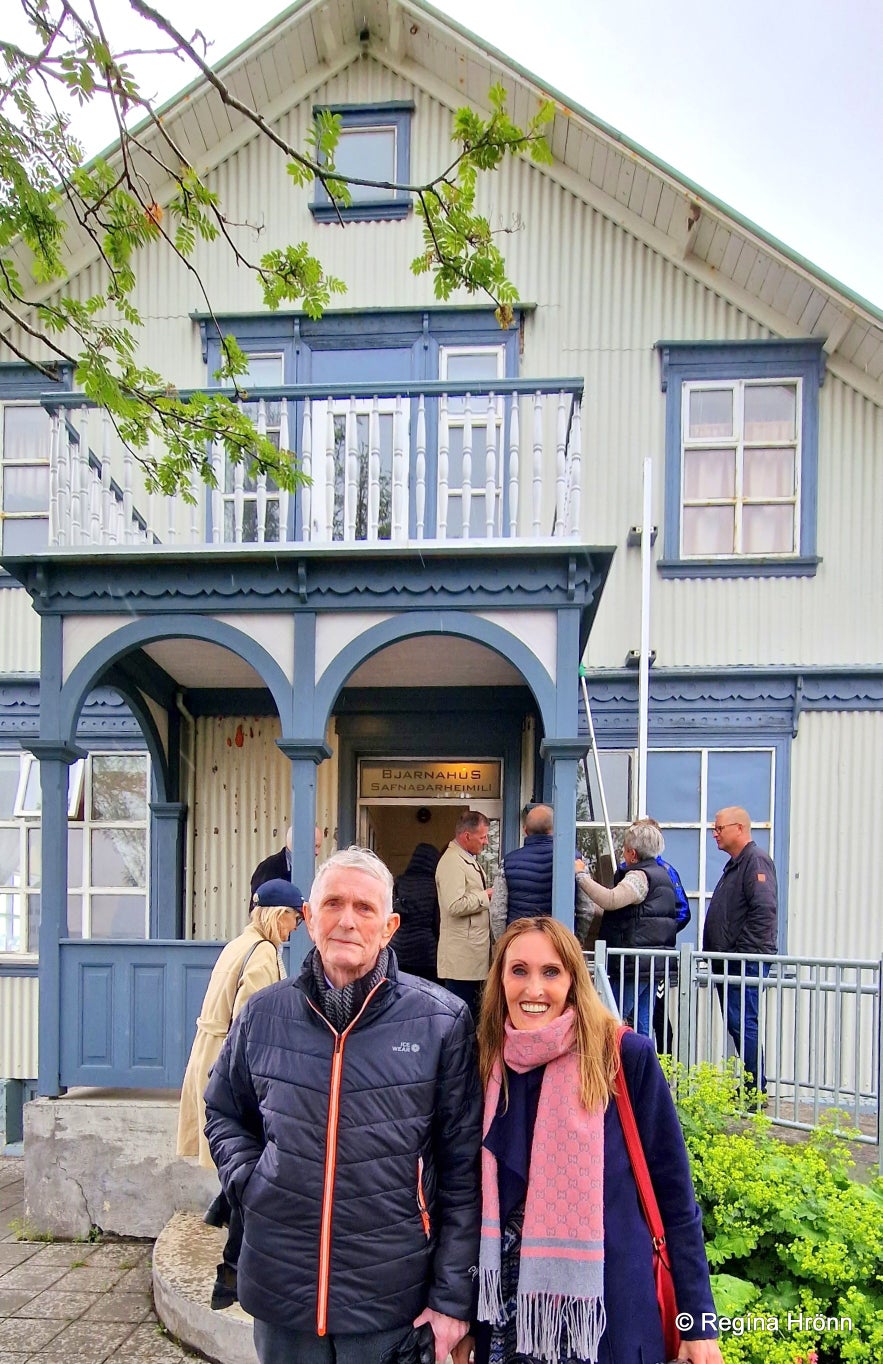 With my relative Þórhallur and more relatives in front of Bjarnahús, but he was born in this house
With my relative Þórhallur and more relatives in front of Bjarnahús, but he was born in this house
And the dreaded polar bears came ashore, and these carnivores are hungry when they reach Iceland, as I have told you about in my travel-blog about Þeistareykir, which is not far from Húsavík:
The colourful Þeistareykir Geothermal Area in North Iceland
There was also unprecedented frost, - 36 degrees C at Grímsstaðir á Fjöllum and -33 degrees C in Akureyri!
And in 1917, the dreadful measles struck this area of Iceland again.
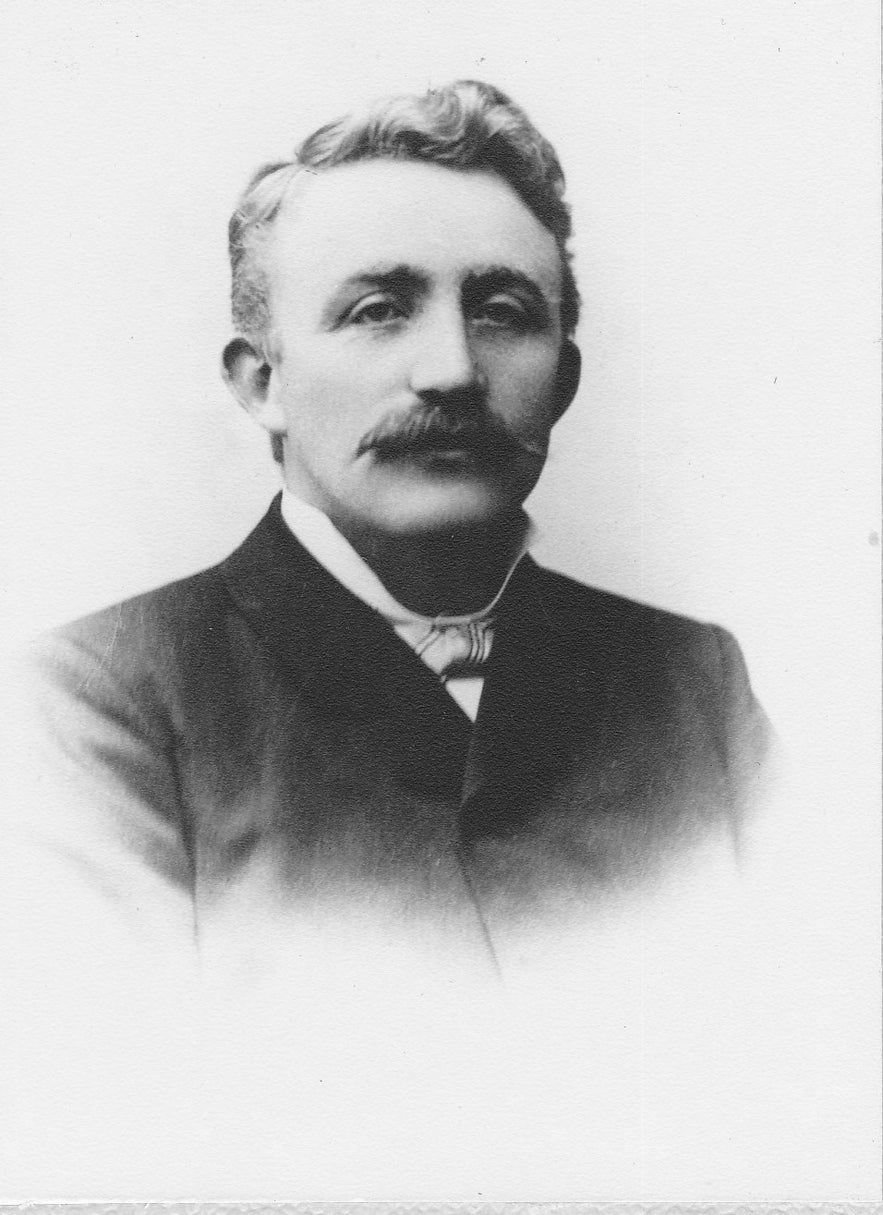 My great-grandfather, Bjarni Benediktsson
My great-grandfather, Bjarni Benediktsson
To keep warm in the cold Bjarnahús house during this period in 1917 in Húsavík, my family, both ill and mobile, gathered in the biggest room where a big oven heated the room with lignite from the mines here at Tjörnes.
The room had turned into a sick room, as many of them had caught the measles. My great-uncle Benedikt, who was only a little boy of 5, died from the measles in 1917, and is buried with my great-great-grandfather, Benedikt, in Húsavík.
Grænlandssteinninn - Torfasteinn rock
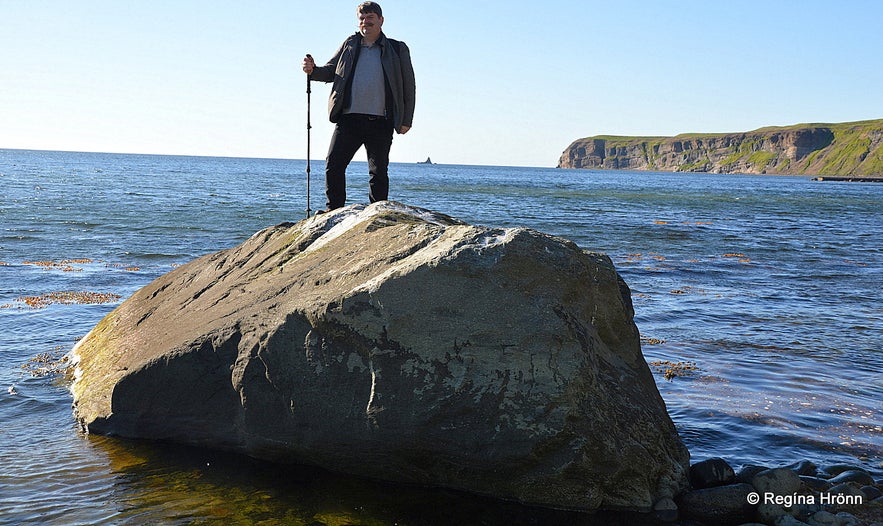 My husband on top of Torfasteinn rock - he always has to climb on everything
My husband on top of Torfasteinn rock - he always has to climb on everything
There are more interesting rocks on the beach, as at the beginning of the hike, you might notice the huge Grænlandssteinninn rock on the foreshore.
But you might not notice it if you don't know what sets it apart from the other rocks on the beach.
This rock is of a different material than the other rocks on the beach, of granite, which cannot be found in Iceland, and it must have drifted all the way from Greenland to Iceland on an iceberg.
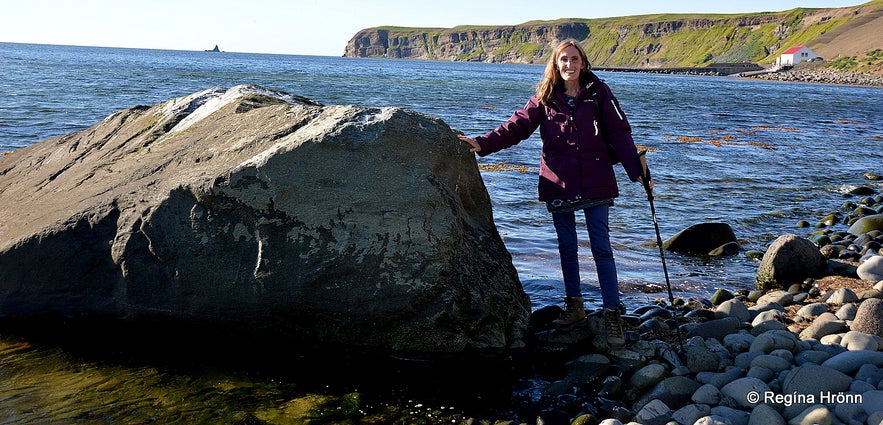 By Torfasteinn rock
By Torfasteinn rock
There are a couple of such granite rocks in Iceland, and I know that one of them is in the Strandir area in the Westfjords of Iceland.
This rock is called Torfasteinn - the Rock of Torfi.
Legend has it that two farmhands at a nearby farm were in love with the same girl. Out of jealousy, after they had both competed for the girl's love, one of the farmhands murdered the other one called Torfi.
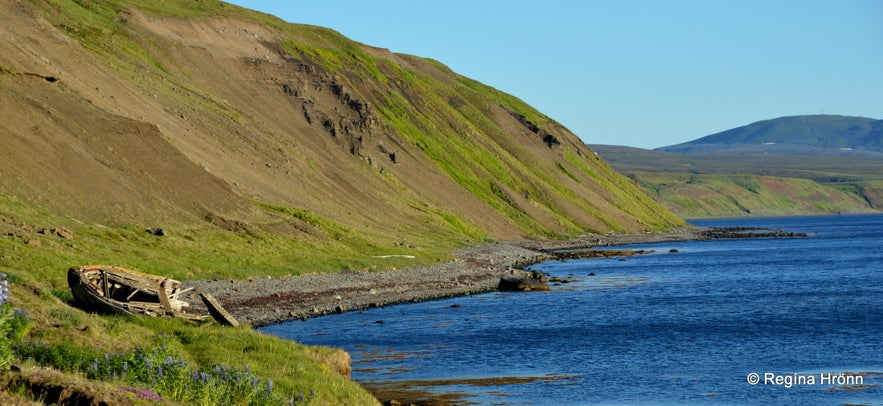 A boat wreck on the beach
A boat wreck on the beach
He then rowed with the body out to sea and threw his body overboard. But as fate has it, the body washed ashore next to the stone, which was since then called Torfasteinn, named after the farmhand Torfi, who was murdered.
I have not been able to find the source for this though, so I don't know when this happened.
Now, let's have a look at Tjörneslögin - the Tjörnes fossils.
Tjörneslögin - the Tjörnes fossils
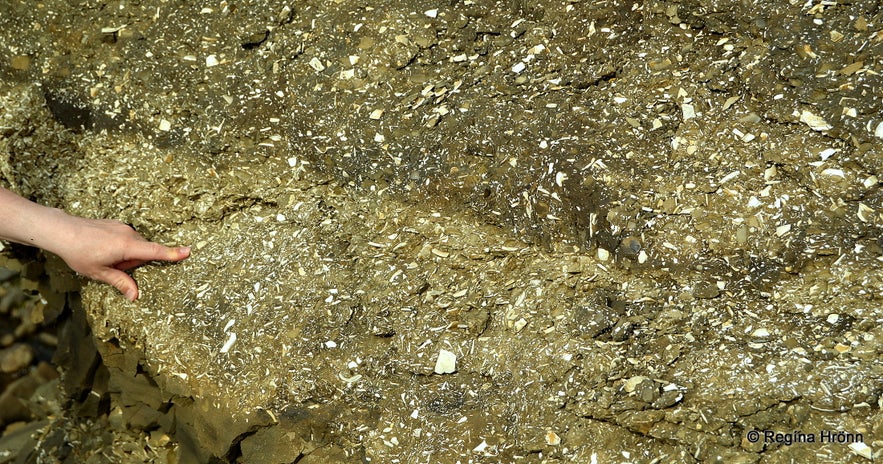
Fossil layers in the rock walls
In this area, you will find Tjörneslögin, sedimentary strata, and the Tjörnes peninsula is best known for these unique fossil layers.
Tjörneslögin sedimentary strata can be found between Köldukvísl and Höskuldsvík, and they are 520 meters thick.
The oldest parts of Tjörneslögin are 4-5 million years old.
It is amazing to examine the sedimentary strata, and here one can see changes in climate, marine life, and vegetation from the beginning of the Ice Age.
These fossils contain a record of climate changes in the North Atlantic.
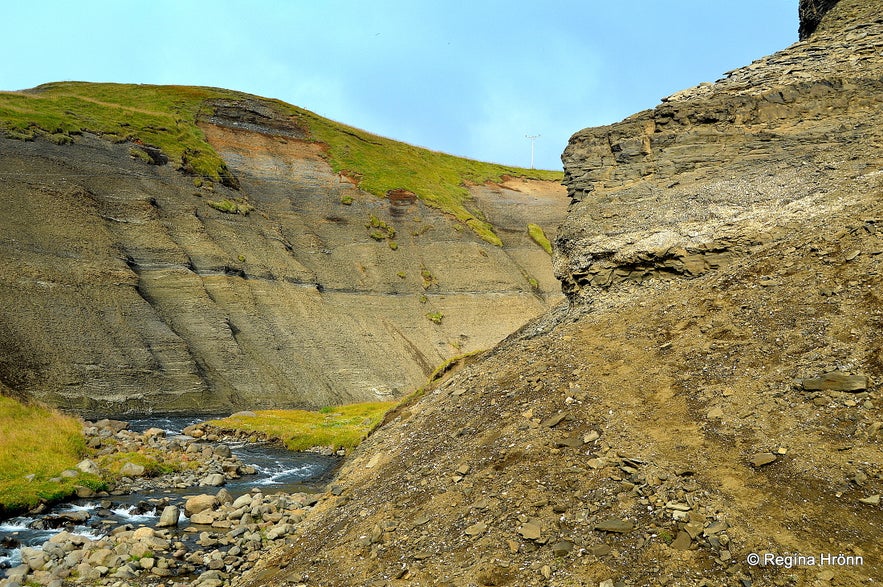 Tjörneslögin sequence by the river Hallbjarnarstaðaá
Tjörneslögin sequence by the river Hallbjarnarstaðaá
Here on the Tjörnes peninsula, you can just walk straight to the fossils and touch them. The slope is completely made up of densely packed fossil shells.
Geology students from the University of Iceland and from around the world come to this place to study fossils. Due to the interaction of fire and ice (lava and glaciers), nowhere else in the world can one find an equal to the strata at Tjörnes.
We have some preserved areas in Reykjavík with sedimentary strata, like Fossvogslögin, but nowhere else in Iceland have I seen anything like the fossils Tjörneslögin layers.
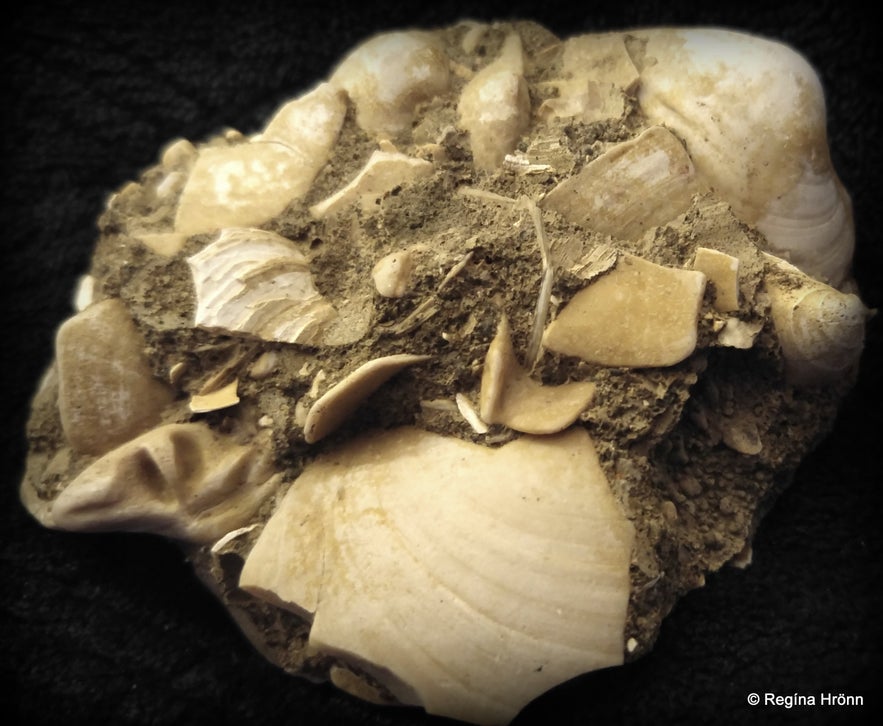 Tjörnes fossils
Tjörnes fossils
This area is not yet preserved, and I cannot fathom why, but it is listed on the Nature Conservation Register as a natural site (náttúruminjar - no 530), and nature preservation law number 60/60/2013 states that it is prohibited to remove the fossils.
Hopefully, this area will be protected soon.
The cliffs at Tjörnes are a cross-section of millions of years of history, and we would have spent more time examining them hadn't our goal been to visit Skeifárfoss waterfall with the sun shining directly at it.
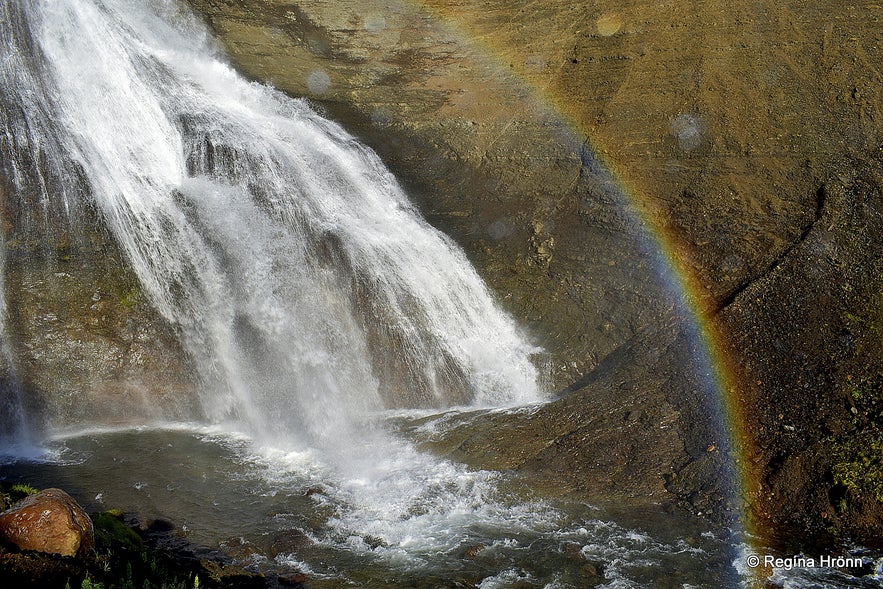
A rainbow by Skeifárfoss
As always, let’s remember to tread lightly in this very fragile area, and only take photos and leave nothing but footprints. This area is delicate and cannot withstand much traffic.
I live in Iceland, so I have time to visit the lesser-known areas of Iceland, as I want to tell you the history of these places and show you some hidden pearls of Iceland in my travel-blogs.
But I am not necessarily directing traffic to these places.
Dynjandi - the Jewel of the Westfjords
If you are interested in bridal veil waterfalls like I am, then I have written travel-blogs about 2 other bridal veil waterfalls.
The Jewel of the Westfjords, Dynjandi waterfall:
The magnificent Dynjandi Waterfall - the Jewel of the Westfjords of Iceland
And a less-known waterfall in West Iceland called Hvítserkur:
The majestic Waterfall Hvítserkur in Fitjaá River in West Iceland
Hvítserkur waterfall in West Iceland
Other areas of interest in this area, about which I have written travel-blogs are the Geosea Seabath and Gatanöf arch-rock.
And of course, Húsavík town, the home of my ancestors.
You can also follow the Diamond Circle and the spectacular sights. And this area is part of the Arctic Coast Way, which takes you along the coastline of Iceland.
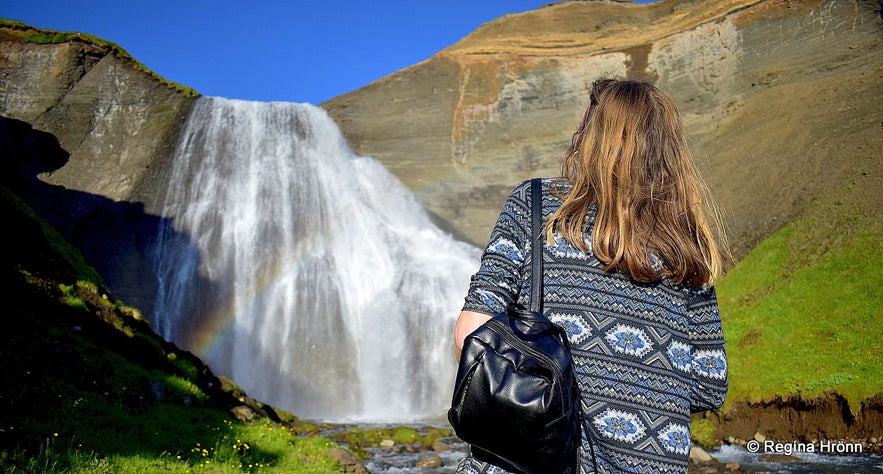 Admiring Skeifárfoss waterfall
Admiring Skeifárfoss waterfall
The hidden-away Skeifárfoss waterfall is located between Hringver, Ytri-Tunga, and Tunguvellir farms.
Tungulending is located at 66.1391624,-17.2650899,1455
Have a lovely time in Iceland chasing waterfalls :)
Ref.:
Umhverfisstofnun - umgengni um náttúru Íslands
Umhverfisstofnun - Tjörneslögin
Vegvísir um jarðfræði Íslands - Exploring Iceland's geology
Tímarit.is - Kolin á Tjörnesi - Jón J. Víðis 1917
155 Áfangastaðir á Íslandi
Stuttur æviannáll Bjarna Benediktssonar, kaupmanns og póstafgreiðslumanns á Húsavík

